
|   |

|   |
Nrityagram comes to Bangalore - Dr Sunil Kothari e-mail: sunilkothari1933@gmail.com Photos courtesy: Nrityagram August 28, 2013 On 18th August, on the occasion of the 15th death anniversary of Protima Bedi, Nrityagram decided to celebrate her memories by showcasing the trainees from tiny tots to those in range of 15 years and above and the finale with three major leading dancers Surupa Sen, Bijayini Satpathy and Pavithra Reddy. "It was Gaurima's (Protima) wish that if she is no more, her departure must not be of mourning, but laughter, fun, joy, celebration," said Surupa Sen, the senior most dancer at Nrityagram in charge of training along with Bijayini Satpathy (they have been at Nrityagram for the past 25 and 20 years respectively), including Pavithra Reddy. This year on Protima's death anniversary, it was decided to invite a few friends and well wishers of Protima and Nrityagram, to hold an 'annual day' at Seva Sadan in Bangalore. Surupa, who conducted the evening, spoke about what they do at Nrityagram. "It is 24x7, for 365 days of the year. Practice, practice and more practice. We are committed and we do not do anything except dance. We live our lives devoted to dancing, training, choreographing, traveling, performing within India and abroad, and it gives us tremendous satisfaction also." She introduced Lynne Fernandez, chief administrator and eminent lights designer, who, during Protima's time was already entrusted with administration work and running it, continuing the lights designing for performances and after Protima's demise took charge of the institution along with Surupa Sen and Bijayini Satpathy, carrying on relentlessly against all odds with their exemplary commitment . 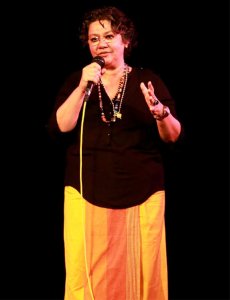 Lynne Fernandez
Lynne recalled the wonderful support late Shankar Nag, the film actor and a friend and his wife Arundhati Nag, an established well known theater actor, gave to Protima from the word go, when Protima established Nrityagram at Hesssarghatta. Arundhati was the MC for the Vasanta Habba, which Protima used to organize year after year. Recognizing presence of others who have been long associated with Protima and Nrityagram, she welcomed me, as I have been associated with Nrityagram from the beginning and regularly visited Nrityagram. Then she introduced Upeka, the daughter of the legendary dancer Chitrasena of Sri Lanka. Upeka has been following Nrityagram dancers since past ten years with their memorable collaboration of Sri Lankan dancers and Odissi in 'Samhara.' They are now a family of Nrityagram. Lynne also welcomed 'grandfather,' the Minister for Petroleum and Energy, Mr. Moily, whose grand daughter Siri Moily is learning Odissi at Nrityagram. Lynne had to go to the lights booth for the lighting and Surupa introduced Lynne's mother June Fernandez, who looks after Nrityagram round the year and in particular when Surupa, Bijayini, Pavithra and Lynne are travelling within India and abroad. There were many elders, artists, admirers, supporters and parents of young dancers studying under Bijayani, Pavithra and Surupa, who were warmly welcomed during the evening. The purpose of this annual show was to let people know what training is given at Nrityagram and how dancers of various age groups progress. Today, both Surupa and Bijayini along with Pavithra have become internationally famous as celebrated Odissi exponents from Nrityagram. Said Surupa, "We have not known anything besides dance and we live our lives dancing, practicing, choreographing, teaching and of course there is little in terms of fortune, meaning money, but we carry on. And this evening we wish to share with you what we do at Nrityagram in terms of teaching and performing." At the beginning before starting introduction, to share the spirit of fun that Protima always used to have, Surupa asked if anyone present would share a joke. None volunteered. So Surupa narrated a funny incident. She and her father who was in the military, were at a club sitting besides a Sardarji, who was telling about his family members, some were engineers, brilliant information technology experts and so on and spoke nearly for thirty minutes non-stop. Then realizing that Surupa and her father were listening politely to his non-stop talking, he asked what Mr. Sen did. He said, "I am an officer in the army and my daughter is a dancer." The Sardarji was struck dumb and did not know what to say. So he said, "Not to worry, sir, after some time sab thik ho jayega!" (Meaning the daughter who is learning dance would be a normal girl). But the girl did not give up dancing. She became a famous dancer and continues to perform and teach. Surupa teaches some fifty students twice a week at Bangalore city, some continue, some give up, and the strict training makes them aware of 'their muscles they did not know how they worked' and the physical exhilaration they experience makes them continue to go through the grill. 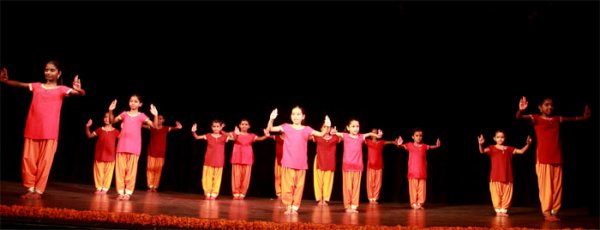 Tiny tots The dancers totaling fourteen in age group of 15 and above, showed basic stance, turned into circles, showed how they lifted their bodies in jumps, extended their arms and with perfect synchronization executed Odissi movements. They gave glimpses of their training and preparations for performing dance numbers. Some of them like Urmi, Akshiti, Prithvi, Shravasti, Arati, Jena, Prabha to name a few danced with others with prior rehearsals in unison. Surupa explained and showed how gradually a dancer is trained. What appeared simple developed into complex time cycle, rhythm and was full of joyous feelings. A prayer in praise of Lord Ganapati was performed by a group of fourteen dancers. The original choreography by Guru Kelucharan Mohapatra was restaged by Surupa. The flawless performance by the dancers striking sculpturesque postures, describing the attributes of dancing Ganapati were imaginatively choreographed in a group presentation. When one saw it, one immediately admired the patience with which the step by step training was given and movements were grasped by them. When they completed the prayer and stood in half crescent formation on stage, one saw their disciplined manner of standing on the stage and also imaginatively choreographed exits. 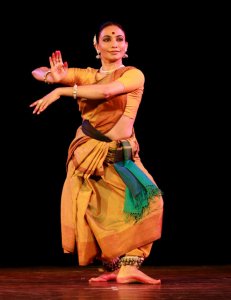 Bijayini Satpathy 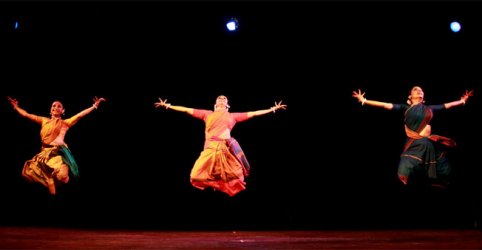 Bijayini, Surupa, Pavithra 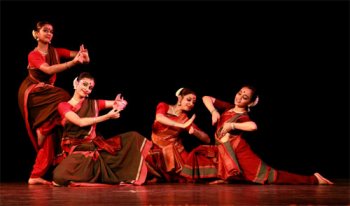
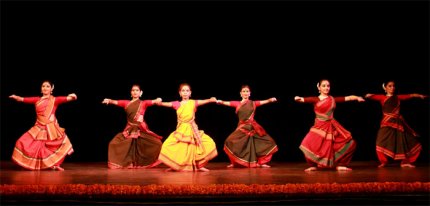
senior dancers
A traditional pure dance number Basanta Pallavi was for the first time
performed by a group of four dancers from Nrityagram, some from summer
course, some training for a brief period. Urmi, Akshati, Prithvi and
Shravasti were selected to present this Pallavi. The dhyana shloka,
describing the image of Basanta raga enacted by dancers through hand
gestures, mudras and body positions, turning into trees, buds and
blossoming into flowers, gentle breeze and so on creating the celebrated
ambience of spring won instant applause as the music enchanted one and
all. The music by legendary late Bhubaneswar Misra is so evergreen and
lifts the item to an aesthetic experience.The finale of course was planned to show the choreographic piece Shivashtakam in praise of Lord Shiva, by Surupa Sen along with Bijayini and Pavithra. Bijayini first explained the meaning of the Sanskrit text with facial expressions, hand gestures and body positions, giving entry points to audience to the performance. This practice of acquainting the audience is most welcome and the renowned painter / sculptor Mr. Balan sitting next to me appreciated as did others. Lord Shiva with his adornments of crescent moon on his Jata, matted locks, the serpents which as ornaments entwined his body, the tiger's skin he used for covering his lower body, the third eye which he opened with fire, the consort Parvati by his side, and the Lord being the cause of the Universe, one's being, were danced with such imaginative choreography that one was spellbound. Surupa choreographs these numbers with great diligence, study, meditation, interaction with Bijayini and the musicians to bring out the import of the shloka, its poetic content and the possibilities of exploration, both in terms of space and time, dividing impersonation of various characters including devotees, in a manner which offers to the connoisseurs delight and to those who may not even know all the nuances, an experience which they relish by sheer power of energetic dancing. Of course, Lynne's exquisite lighting illumines the dancers as per the moods they evoke and create a magic which lingers long after the performance gently concludes. It was a delight to watch this presentation which the Bangalore city audiences saw and enjoyed. The Seva Sadan auditorium was full, audience sitting on the floor, standing on the side and enjoying the fare. Nrityagram artistes are planning to hold the annual show regularly every year, in a larger auditorium in Bangalore where more people can witness this showcasing of the young dancers who study at Nrityagram during workshops, regular classes, classes held in city and so on. That Nrityagram has created its own signature style in Odissi is known to all. Therefore a presentation of this nature is most welcome to take one behind the scenes and share with them how a dancer is prepared. Surupa, Bijayini and Pavithra, as mentioned earlier, have been at Nrityagram for over two decades and are known as Nrityagram exponents. Now they want the world to know that the next generation is getting ready and with great confidence shall inherit the legacy of such a high standard.  Dr. Sunil Kothari is a dance historian, scholar, author and a renowned dance critic. He is Vice President of World Dance Alliance Asia Pacific India chapter, based in New Delhi. He is honored by the President of India with Padma Shri, Sangeet Natak Akademi award and Senior Critic Award from Dance Critics Association, NYC. He is a regular contributor to www.narthaki.com, the roving critic for monthly magazine Sruti and is a contributing editor of Nartanam for the past 12 years. Post your comments Pl provide your name and email id along with your comment. All appropriate comments posted with name and email id in the blog will also be featured in the site. |